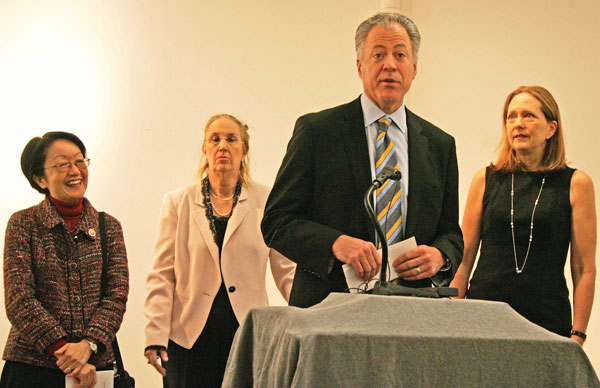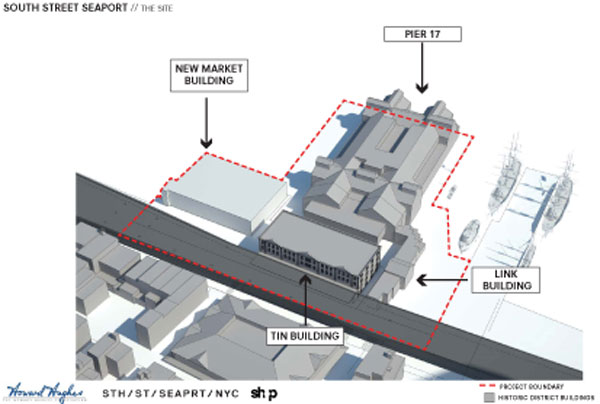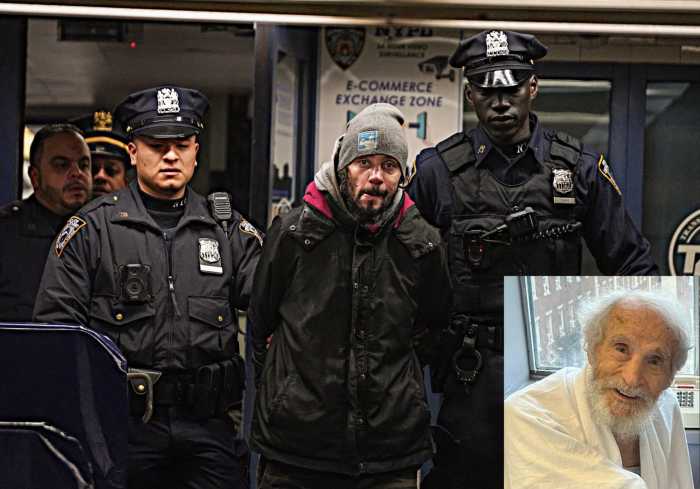
Seaport developer Chris Curry of Howard Hughes Corp. joined with Councilmember Margaret Chin, left, Gail Brewer, Manhattan borough president, and Catherine McVay Hughes of Community Board 1 to announce the members of the Seaport Working Group.
BY JOSH ROGERS UPDATED FEB. 28, 2014 WITH A SEAPORT WORKING GROUP STATEMENT AFTER THE FIRST MEETING | Now the Seaport work begins.
Last November, Howard Hughes Corp. announced plans to redevelop the South Street Seaport with a 600-foot mixed use building, which drew near universal opposition from local leaders.
A month ago, the firm agreed to join these leaders in a working group to find consensus. On Tuesday night, they came together to say they had agreed who would be in the group.
Now the Seaport Working Group hopes to find consensus in the next three months before Hughes Corp. goes forward with a formal application to develop the New Market Building, the tower site, the Tin Building and the surrounding area.
“You’ve asked for it and you’ve got it,” a triumphant Councilmember Margaret Chin, said Feb. 25, at a press conference at the beginning of Community Board 1’s full board meeting.
Consensus will no doubt be difficult since the group includes Hughes and a few of its supporters such as the Downtown Alliance, as well as people who favor landmarking the proposed tower site, the New Market Building, including members of Community Board 1 and Save Our Seaport.
Chris Curry, who is overseeing the Seaport project for Hughes, said he looked forward to working with the community.
“We embrace the historical significance of the place, and we believe this process is a great step forward for the project” he said, as he stood with three of the group’s leaders — Chin, Borough President Gail Brewer and Catherine McVay Hughes, C.B. 1’s chairperson who has no connection to the corporation.
The goal of the group, according to the Feb. 25th press release announcing it, is to develop a set of “governing principles” that will guide any development proposals.

Schematic of the proposed Seaport development area. The tower would be at the New Market site. The redevelopment of the Pier 17 mall was approved last year.
The final plan should complement the historic district, while it “maintains vital Seaport infrastructures, and reflects the increasing need for services and amenities geared toward Lower Manhattan’s growing residential population.”
Brewer, who last year was the only city councilmember to oppose the Hughes firm’s plan to redevelop nearby Pier 17, said she thought consensus was possible.
One of the leading opponents of Hughes’ plans, Robert LaValva, founder of the Seaport’s New Amsterdam Market, will not be on the group.
“I am very fond of Robert, but he’s not going to be at the meetings, but he will be represented at the meetings,” Brewer said, in an apparent reference to groups he’s closely allied with, like Save Our Seaport.
LaValva, who had formally asked to join the group, wrote in an email to Downtown Express Wednesday that he hoped the Working Group takes “this opportunity to reconsider the original vision for the Seaport to evolve as a treasured destination for all New Yorkers.
“Since 2007, New Amsterdam Market, its customers, and supporters have… built the foundation of a cherished community amenity that is also [a] proven magnet for customers … who support local small businesses. We will welcome the Working Group’s … consideration of our proposed redevelopment of the Fulton Fish Market and other public amenities.”
As part of last year’s Pier 17 deal, Hughes committed to opening two 10,000 square-foot food markets — one in the Link Building and the second in the Tin, although the second one would be dependent on getting some version of the current plan approved by the city.
LaValva, in an interview last week, said there were two essential problems with the proposed Hughes’ markets —one is that they would be too small to create the vibrancy of something like Seattle’s Pike Place Market. The other is that by destroying one former Fulton Fish Market building, New Market, and altering another, the Tin, the plan’s effect would be to diminish neighborhood’s historic market character.
The Hughes team counters that the city Landmarks Preservation Commission has rejected previous attempts to add the New Market Building to the historic district, and that demolishing the building would open new access points to the waterfront, a long-held goal of Board 1.
Large food markets are another desire of the community board, as well as the larger community.
Jeremy Soffin, a spokesperson for the Hughes Corp., said last week that food shopping was far and away the most popular thing people wanted, according to the thousands of surveys the firm mailed to Lower Manhattan residents and others.
“People want a supermarket,” said Soffin. “Trader Joe’s is surprisingly popular.”
He declined to mention any more results from the survey, saying the firm would unveil more details at the Working Group’s first closed-door meeting, which was Thurs., Feb. 27 in Assembly Speaker Sheldon Silver’s office.
At the meeting, the city’s Economic Development Corp., which is the Hughes Corporation’s landlord at South Street Seaport and is providing the working group with technical assistance, made a presentation to the group, which released a joint statement afterwards.
The working group released a joint statement after the meeting, saying, “Today, we took a step toward an effort to encourage a diverse array of community stakeholders to provide their input on the future of this incredibly important, historic neighborhood. For our Lower Manhattan community – which has survived the devastation of Superstorm Sandy, only to emerge stronger than before – we hope this is a chance to continue our transformation into one of our city’s most vibrant neighborhoods.”
The next meeting is March 6 in Brewer’s office.

Rendering of the proposed marina at the South Street Seaport, which is part of the Howard Hughes Corp. development plan.
Borough President Brewer and Councilmember Chin said Tuesday night that the community board would be giving the public regular briefings about the discussions.
Kyle Kimball, E.D.C. president under both Mayor de Blasio as well as former Mayor Bloomberg, joined the Feb. 25 press release announcing the new group.
“We look forward to assisting all local stakeholders in establishing their priorities for a mixed-use development project in this iconic area,” Kimball said in a prepared statement. “We thank Councilmember Chin and other local elected leaders for steering this important effort.”
Chin, who will have a key negotiating role before a plan comes to the City Council for an up or down vote, said Tuesday night, there would be “a lot of work, a lot of meetings the next couple of weeks, the next couple of months….
“How do we preserve the South Street Seaport that we all love so much — what about the [Seaport] Museum that we want to make sure will grow and thrive?”
Seaport Working Group
Below is the list of people and organizations named to the new group:
U.S. Rep. Jerrold Nadler, N.Y.S. Assembly Speaker Sheldon Silver, Manhattan Borough President Gale Brewer. N.YS. Senator Daniel Squadron City Councilmember Margaret Chin, Community Board 1 Chair Catherine McVay Hughes, CB1 Seaport/Civic Center Committee Chair John Fratta, CB1 Landmarks Committee Chair Roger Byron CB1 Planning and Infrastructure Committee Chair Jeff GallowayThe Howard Hughes Corporation Save Our Seaport Seaport SpeaksOld Seaport AllianceThe Downtown AllianceThe Manhattan Chamber of Commerce Lower Manhattan Cultural Council Allison Gaines Pell, Head of the Blue School Diane Harris Brown, Downtown resident and director of Educational and Community Programming at the James Beard Foundation, Charles Jaskel, local resident, Jonathan O’Donnell, 95 John Street Board of Directors, Paul Kefer, Southbridge Towers Board of Directors.
— With reporting by Sam Spokony

































